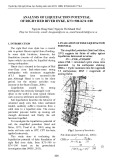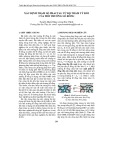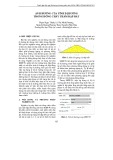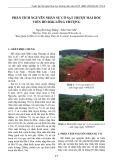
Advances in Natural Sciences, Vol. 7, No. 1 & 2 (2006) (107 – 119)
Chemistry
NEW MONOMERS FOR CHEMICAL VAPOR
DEPOSITION POLYMERIZATION OF
POLY(P-XYLYLENE)
Nguyen Duc Nghia, Ngo Trinh Tung
Institute of Chemistry, VAST
Jung-Il Jin
Department of Chemistry, Korea University
Abstract. It was demonstrated that Poly(p-Xylylene) (PPX) could be prepared from
α,α’-Bis(Alkoxy or Aryloxy) –p-Xylenes via chemical vapor decomposition (CVD)-
method. This is one-step process and there are side products by the CVD-process. This
effect depends both on the CVD- condition and the properties of the starting monomer.
The structure and thermal behavior of the material were characterized by FTIR, UV-
vis spectroscopy, elemental analysis, wide-angle X-ray diffraction, DTA and DSC. It
could be showed that the deposited PPX is semicrystalline and the melting process
of PPX is characterized by the two crystalline phase transition and accompanied by
decomposition. This research will open a new way to synthesize of PPX.
1. INTRODUCTION
Poly(p-xylynene) (PPX) and its derivatives have potential as interlayer di-
electrics because of their high thermal and chemical stability, excellent mechanical
properties, low dielectric constant, and the fact that they can be synthesized and
processed as thin coatings by chemical vapor deposition (CVD) [1,2]. The advan-
tage of CVD-material, in particular, is that the CVD film deposition is generally
conformal, exhibits good gap-fill properties. The deposition process is also sol-
ventless, which minimizes chemical disposal cost. The first preparation of PPX
-film via CVD was reported by Gorham [3]. Although Gorham process is the
most popular method of PPX polymerization, but because of their limitation
of the availability of paracyclophane and the vaporizability of substituted para-
cyclophane, many other synthetic route for PPX are developed [1, 4-7]. Fig. 1
shows the different polymerization schemes used for CVD of PPX thin film.
In this paper, we present a new polymerization scheme of PPX thin film
via CVD method. As the starting material, the monomer based on the ether-
compounds was used. The reaction mechanism by CVD-process was investigated
and the influence of the CVD-condition on the deposited material was discussed.
The structure and thermal behavior of the deposition material was characterized
by FT-IR, UV-vis, elemental analysis, TGA, DSC and X-ray diffraction.






























